Evaluating Social/Environmental Factors Influencing Rift Valley Fever
VerifiedAdded on 2022/11/28
|12
|3251
|76
Project
AI Summary
This project presents a comprehensive study evaluating the social and environmental factors that influence Rift Valley Fever (RVF) in the Jizan region of Saudi Arabia. The research aims to understand the relationship between these factors and the occurrence of RVF, a viral zoonosis affecting both animals and humans. The study focuses on nomadic pastoralists, a high-risk population in this region, and employs a cross-sectional and experimental design, including ELISA tests, to collect and analyze data over a three-year period. The project investigates factors like temperature, humidity, and social practices. Ethical considerations and study limitations are addressed, along with the potential impacts of the study, such as improved disease control and the development of best practices for animal rearing. The research question centers on identifying the specific social and environmental factors that contribute to RVF outbreaks in Jizan.
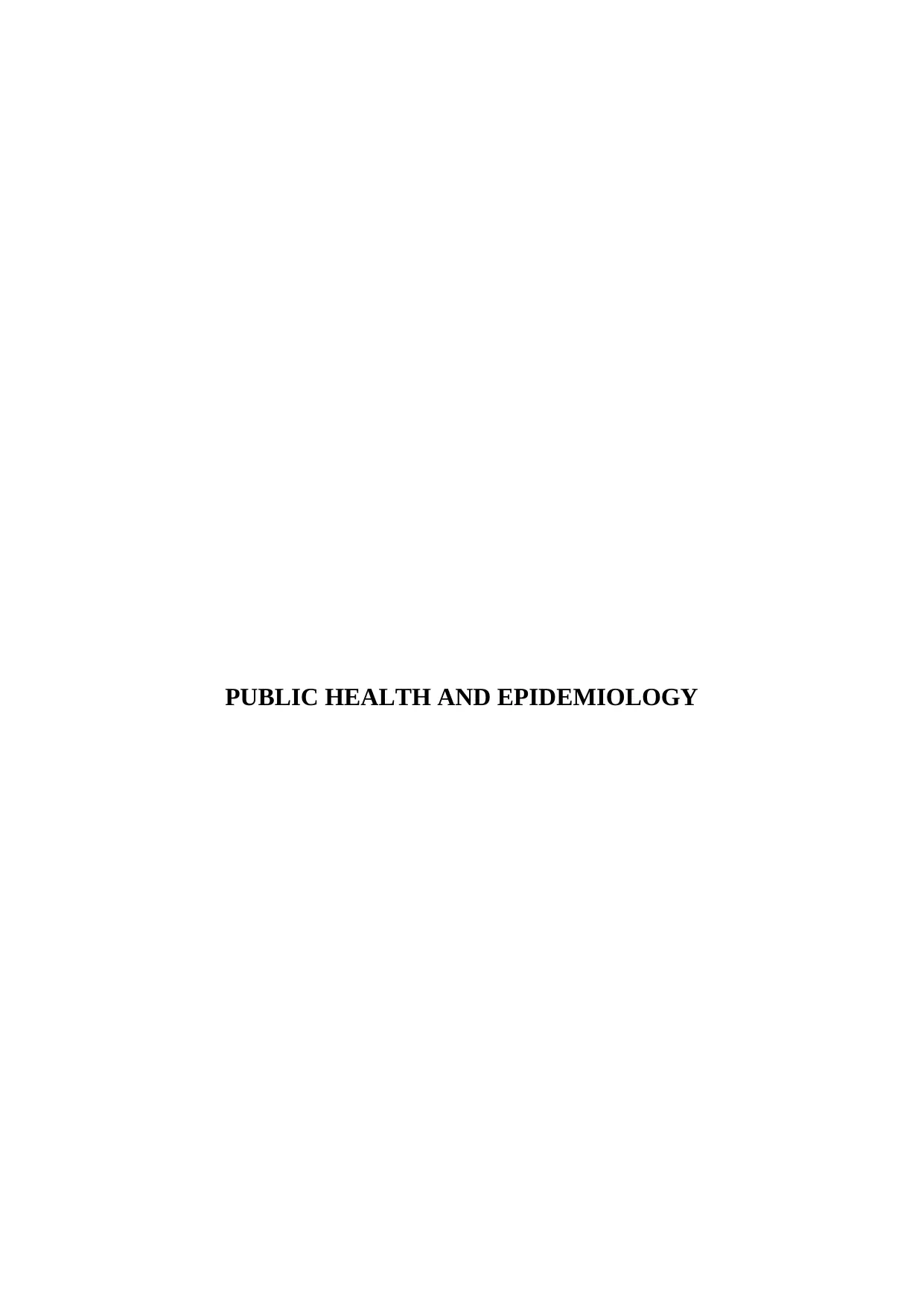
PUBLIC HEALTH AND EPIDEMIOLOGY
Paraphrase This Document
Need a fresh take? Get an instant paraphrase of this document with our AI Paraphraser
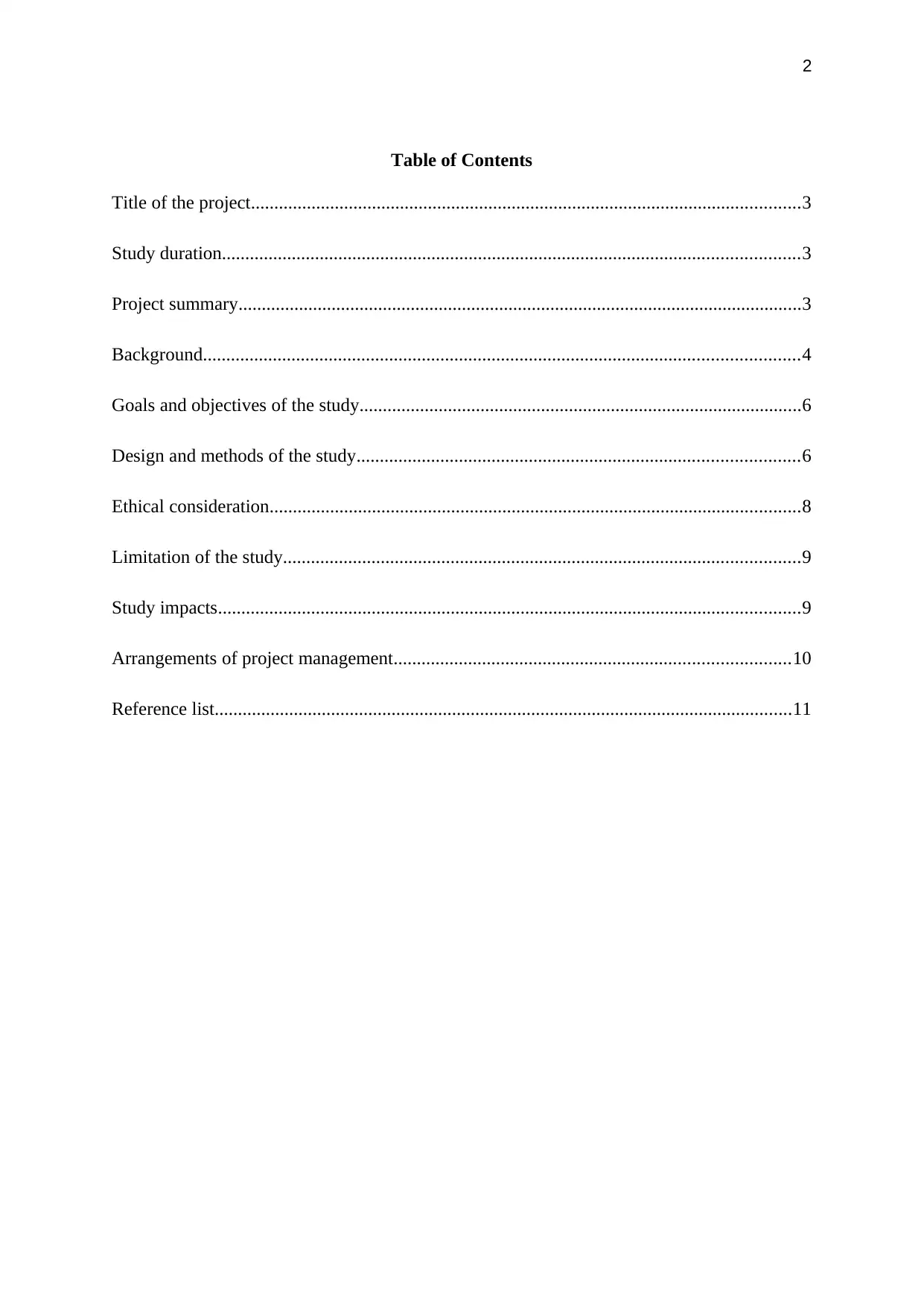
2
Table of Contents
Title of the project......................................................................................................................3
Study duration............................................................................................................................3
Project summary.........................................................................................................................3
Background................................................................................................................................4
Goals and objectives of the study...............................................................................................6
Design and methods of the study...............................................................................................6
Ethical consideration..................................................................................................................8
Limitation of the study...............................................................................................................9
Study impacts.............................................................................................................................9
Arrangements of project management.....................................................................................10
Reference list............................................................................................................................11
Table of Contents
Title of the project......................................................................................................................3
Study duration............................................................................................................................3
Project summary.........................................................................................................................3
Background................................................................................................................................4
Goals and objectives of the study...............................................................................................6
Design and methods of the study...............................................................................................6
Ethical consideration..................................................................................................................8
Limitation of the study...............................................................................................................9
Study impacts.............................................................................................................................9
Arrangements of project management.....................................................................................10
Reference list............................................................................................................................11
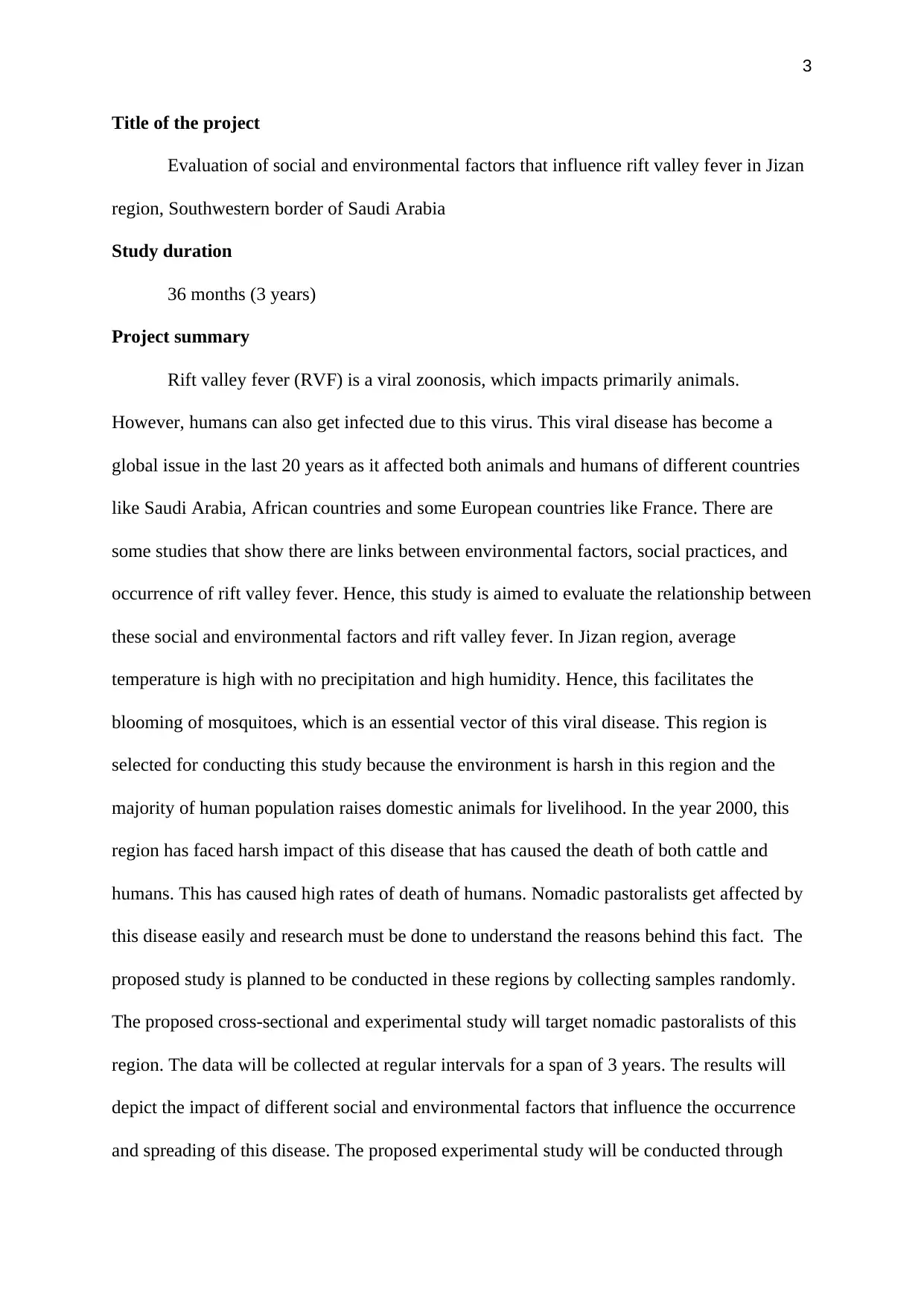
3
Title of the project
Evaluation of social and environmental factors that influence rift valley fever in Jizan
region, Southwestern border of Saudi Arabia
Study duration
36 months (3 years)
Project summary
Rift valley fever (RVF) is a viral zoonosis, which impacts primarily animals.
However, humans can also get infected due to this virus. This viral disease has become a
global issue in the last 20 years as it affected both animals and humans of different countries
like Saudi Arabia, African countries and some European countries like France. There are
some studies that show there are links between environmental factors, social practices, and
occurrence of rift valley fever. Hence, this study is aimed to evaluate the relationship between
these social and environmental factors and rift valley fever. In Jizan region, average
temperature is high with no precipitation and high humidity. Hence, this facilitates the
blooming of mosquitoes, which is an essential vector of this viral disease. This region is
selected for conducting this study because the environment is harsh in this region and the
majority of human population raises domestic animals for livelihood. In the year 2000, this
region has faced harsh impact of this disease that has caused the death of both cattle and
humans. This has caused high rates of death of humans. Nomadic pastoralists get affected by
this disease easily and research must be done to understand the reasons behind this fact. The
proposed study is planned to be conducted in these regions by collecting samples randomly.
The proposed cross-sectional and experimental study will target nomadic pastoralists of this
region. The data will be collected at regular intervals for a span of 3 years. The results will
depict the impact of different social and environmental factors that influence the occurrence
and spreading of this disease. The proposed experimental study will be conducted through
Title of the project
Evaluation of social and environmental factors that influence rift valley fever in Jizan
region, Southwestern border of Saudi Arabia
Study duration
36 months (3 years)
Project summary
Rift valley fever (RVF) is a viral zoonosis, which impacts primarily animals.
However, humans can also get infected due to this virus. This viral disease has become a
global issue in the last 20 years as it affected both animals and humans of different countries
like Saudi Arabia, African countries and some European countries like France. There are
some studies that show there are links between environmental factors, social practices, and
occurrence of rift valley fever. Hence, this study is aimed to evaluate the relationship between
these social and environmental factors and rift valley fever. In Jizan region, average
temperature is high with no precipitation and high humidity. Hence, this facilitates the
blooming of mosquitoes, which is an essential vector of this viral disease. This region is
selected for conducting this study because the environment is harsh in this region and the
majority of human population raises domestic animals for livelihood. In the year 2000, this
region has faced harsh impact of this disease that has caused the death of both cattle and
humans. This has caused high rates of death of humans. Nomadic pastoralists get affected by
this disease easily and research must be done to understand the reasons behind this fact. The
proposed study is planned to be conducted in these regions by collecting samples randomly.
The proposed cross-sectional and experimental study will target nomadic pastoralists of this
region. The data will be collected at regular intervals for a span of 3 years. The results will
depict the impact of different social and environmental factors that influence the occurrence
and spreading of this disease. The proposed experimental study will be conducted through
⊘ This is a preview!⊘
Do you want full access?
Subscribe today to unlock all pages.

Trusted by 1+ million students worldwide
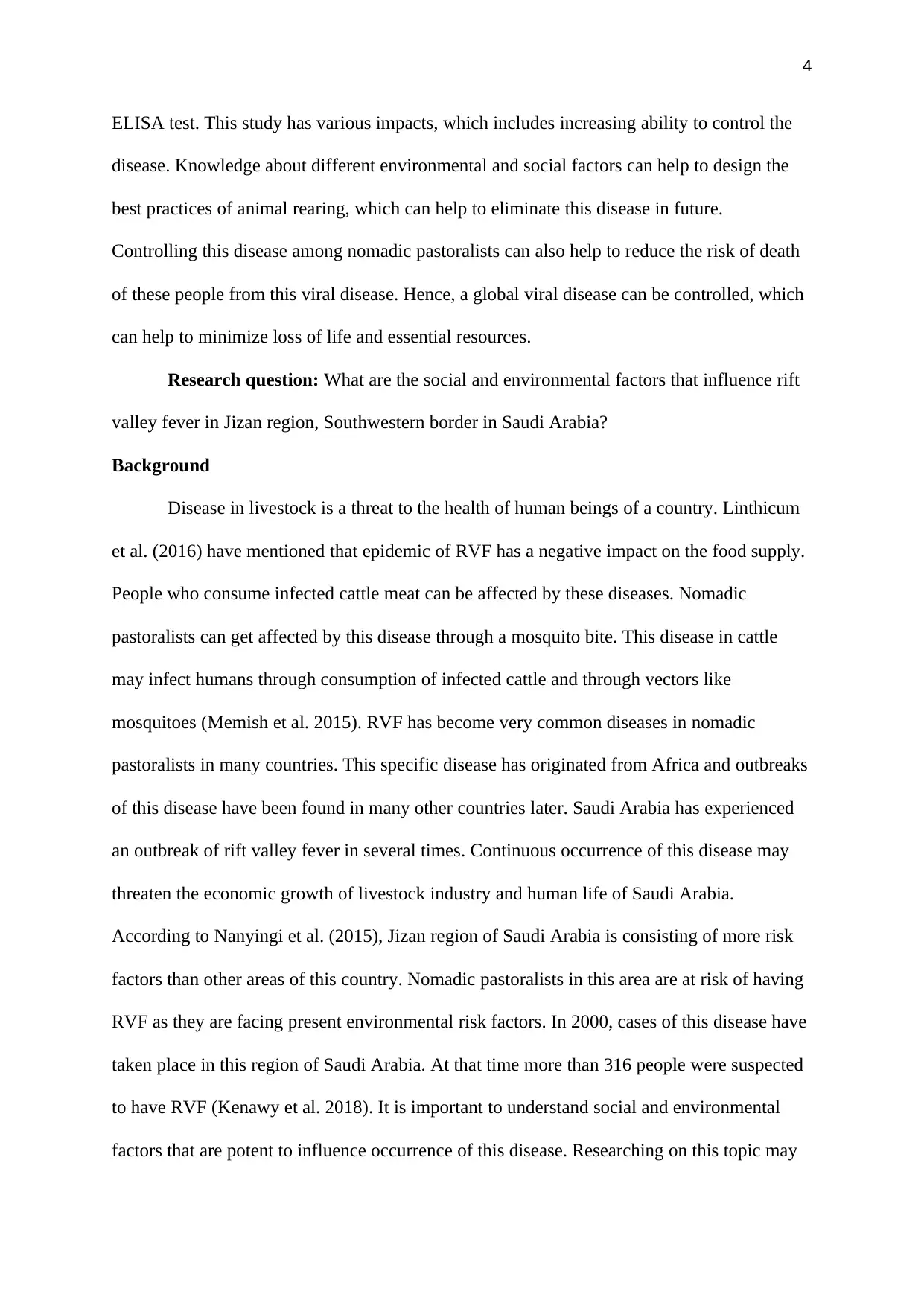
4
ELISA test. This study has various impacts, which includes increasing ability to control the
disease. Knowledge about different environmental and social factors can help to design the
best practices of animal rearing, which can help to eliminate this disease in future.
Controlling this disease among nomadic pastoralists can also help to reduce the risk of death
of these people from this viral disease. Hence, a global viral disease can be controlled, which
can help to minimize loss of life and essential resources.
Research question: What are the social and environmental factors that influence rift
valley fever in Jizan region, Southwestern border in Saudi Arabia?
Background
Disease in livestock is a threat to the health of human beings of a country. Linthicum
et al. (2016) have mentioned that epidemic of RVF has a negative impact on the food supply.
People who consume infected cattle meat can be affected by these diseases. Nomadic
pastoralists can get affected by this disease through a mosquito bite. This disease in cattle
may infect humans through consumption of infected cattle and through vectors like
mosquitoes (Memish et al. 2015). RVF has become very common diseases in nomadic
pastoralists in many countries. This specific disease has originated from Africa and outbreaks
of this disease have been found in many other countries later. Saudi Arabia has experienced
an outbreak of rift valley fever in several times. Continuous occurrence of this disease may
threaten the economic growth of livestock industry and human life of Saudi Arabia.
According to Nanyingi et al. (2015), Jizan region of Saudi Arabia is consisting of more risk
factors than other areas of this country. Nomadic pastoralists in this area are at risk of having
RVF as they are facing present environmental risk factors. In 2000, cases of this disease have
taken place in this region of Saudi Arabia. At that time more than 316 people were suspected
to have RVF (Kenawy et al. 2018). It is important to understand social and environmental
factors that are potent to influence occurrence of this disease. Researching on this topic may
ELISA test. This study has various impacts, which includes increasing ability to control the
disease. Knowledge about different environmental and social factors can help to design the
best practices of animal rearing, which can help to eliminate this disease in future.
Controlling this disease among nomadic pastoralists can also help to reduce the risk of death
of these people from this viral disease. Hence, a global viral disease can be controlled, which
can help to minimize loss of life and essential resources.
Research question: What are the social and environmental factors that influence rift
valley fever in Jizan region, Southwestern border in Saudi Arabia?
Background
Disease in livestock is a threat to the health of human beings of a country. Linthicum
et al. (2016) have mentioned that epidemic of RVF has a negative impact on the food supply.
People who consume infected cattle meat can be affected by these diseases. Nomadic
pastoralists can get affected by this disease through a mosquito bite. This disease in cattle
may infect humans through consumption of infected cattle and through vectors like
mosquitoes (Memish et al. 2015). RVF has become very common diseases in nomadic
pastoralists in many countries. This specific disease has originated from Africa and outbreaks
of this disease have been found in many other countries later. Saudi Arabia has experienced
an outbreak of rift valley fever in several times. Continuous occurrence of this disease may
threaten the economic growth of livestock industry and human life of Saudi Arabia.
According to Nanyingi et al. (2015), Jizan region of Saudi Arabia is consisting of more risk
factors than other areas of this country. Nomadic pastoralists in this area are at risk of having
RVF as they are facing present environmental risk factors. In 2000, cases of this disease have
taken place in this region of Saudi Arabia. At that time more than 316 people were suspected
to have RVF (Kenawy et al. 2018). It is important to understand social and environmental
factors that are potent to influence occurrence of this disease. Researching on this topic may
Paraphrase This Document
Need a fresh take? Get an instant paraphrase of this document with our AI Paraphraser
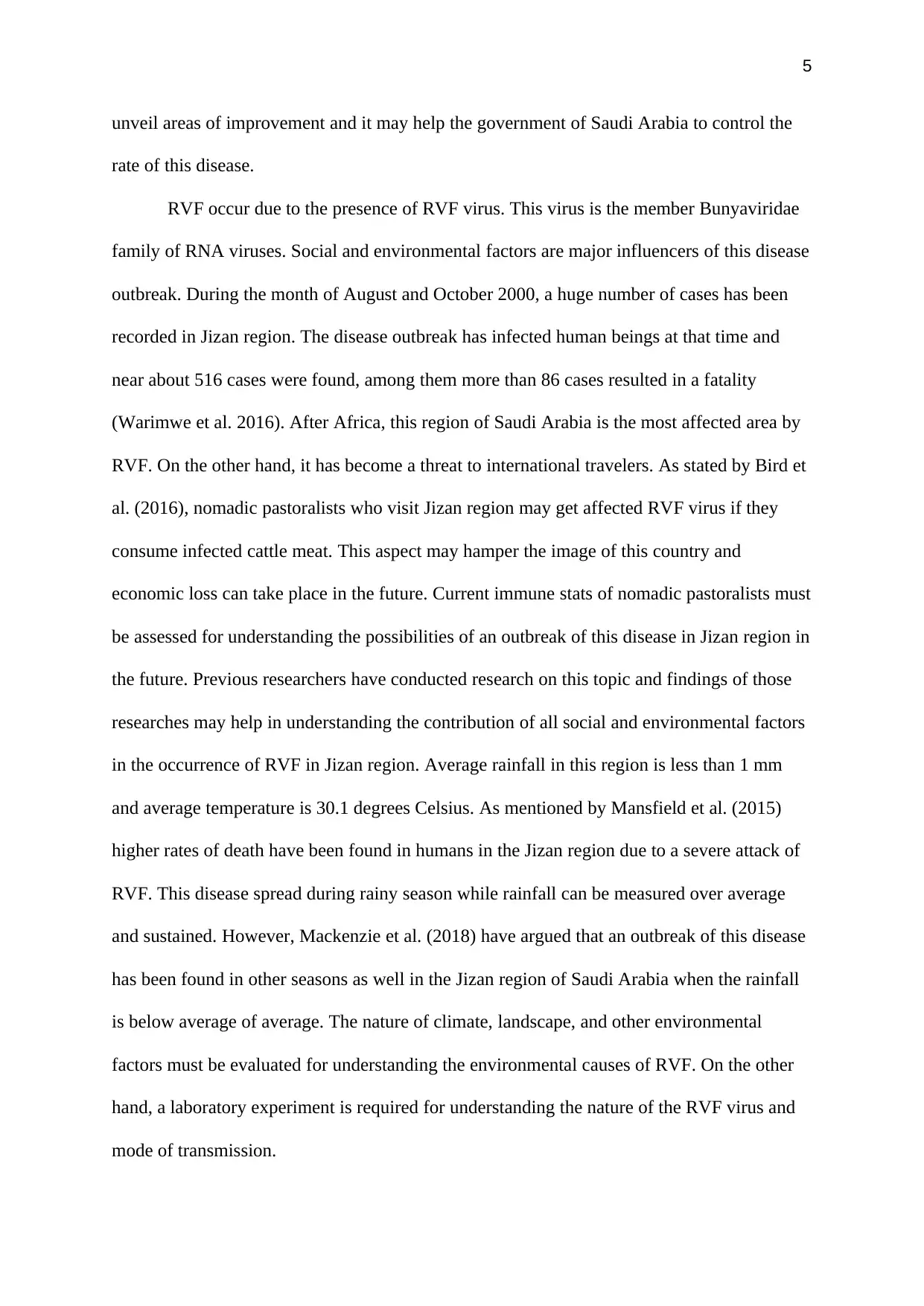
5
unveil areas of improvement and it may help the government of Saudi Arabia to control the
rate of this disease.
RVF occur due to the presence of RVF virus. This virus is the member Bunyaviridae
family of RNA viruses. Social and environmental factors are major influencers of this disease
outbreak. During the month of August and October 2000, a huge number of cases has been
recorded in Jizan region. The disease outbreak has infected human beings at that time and
near about 516 cases were found, among them more than 86 cases resulted in a fatality
(Warimwe et al. 2016). After Africa, this region of Saudi Arabia is the most affected area by
RVF. On the other hand, it has become a threat to international travelers. As stated by Bird et
al. (2016), nomadic pastoralists who visit Jizan region may get affected RVF virus if they
consume infected cattle meat. This aspect may hamper the image of this country and
economic loss can take place in the future. Current immune stats of nomadic pastoralists must
be assessed for understanding the possibilities of an outbreak of this disease in Jizan region in
the future. Previous researchers have conducted research on this topic and findings of those
researches may help in understanding the contribution of all social and environmental factors
in the occurrence of RVF in Jizan region. Average rainfall in this region is less than 1 mm
and average temperature is 30.1 degrees Celsius. As mentioned by Mansfield et al. (2015)
higher rates of death have been found in humans in the Jizan region due to a severe attack of
RVF. This disease spread during rainy season while rainfall can be measured over average
and sustained. However, Mackenzie et al. (2018) have argued that an outbreak of this disease
has been found in other seasons as well in the Jizan region of Saudi Arabia when the rainfall
is below average of average. The nature of climate, landscape, and other environmental
factors must be evaluated for understanding the environmental causes of RVF. On the other
hand, a laboratory experiment is required for understanding the nature of the RVF virus and
mode of transmission.
unveil areas of improvement and it may help the government of Saudi Arabia to control the
rate of this disease.
RVF occur due to the presence of RVF virus. This virus is the member Bunyaviridae
family of RNA viruses. Social and environmental factors are major influencers of this disease
outbreak. During the month of August and October 2000, a huge number of cases has been
recorded in Jizan region. The disease outbreak has infected human beings at that time and
near about 516 cases were found, among them more than 86 cases resulted in a fatality
(Warimwe et al. 2016). After Africa, this region of Saudi Arabia is the most affected area by
RVF. On the other hand, it has become a threat to international travelers. As stated by Bird et
al. (2016), nomadic pastoralists who visit Jizan region may get affected RVF virus if they
consume infected cattle meat. This aspect may hamper the image of this country and
economic loss can take place in the future. Current immune stats of nomadic pastoralists must
be assessed for understanding the possibilities of an outbreak of this disease in Jizan region in
the future. Previous researchers have conducted research on this topic and findings of those
researches may help in understanding the contribution of all social and environmental factors
in the occurrence of RVF in Jizan region. Average rainfall in this region is less than 1 mm
and average temperature is 30.1 degrees Celsius. As mentioned by Mansfield et al. (2015)
higher rates of death have been found in humans in the Jizan region due to a severe attack of
RVF. This disease spread during rainy season while rainfall can be measured over average
and sustained. However, Mackenzie et al. (2018) have argued that an outbreak of this disease
has been found in other seasons as well in the Jizan region of Saudi Arabia when the rainfall
is below average of average. The nature of climate, landscape, and other environmental
factors must be evaluated for understanding the environmental causes of RVF. On the other
hand, a laboratory experiment is required for understanding the nature of the RVF virus and
mode of transmission.
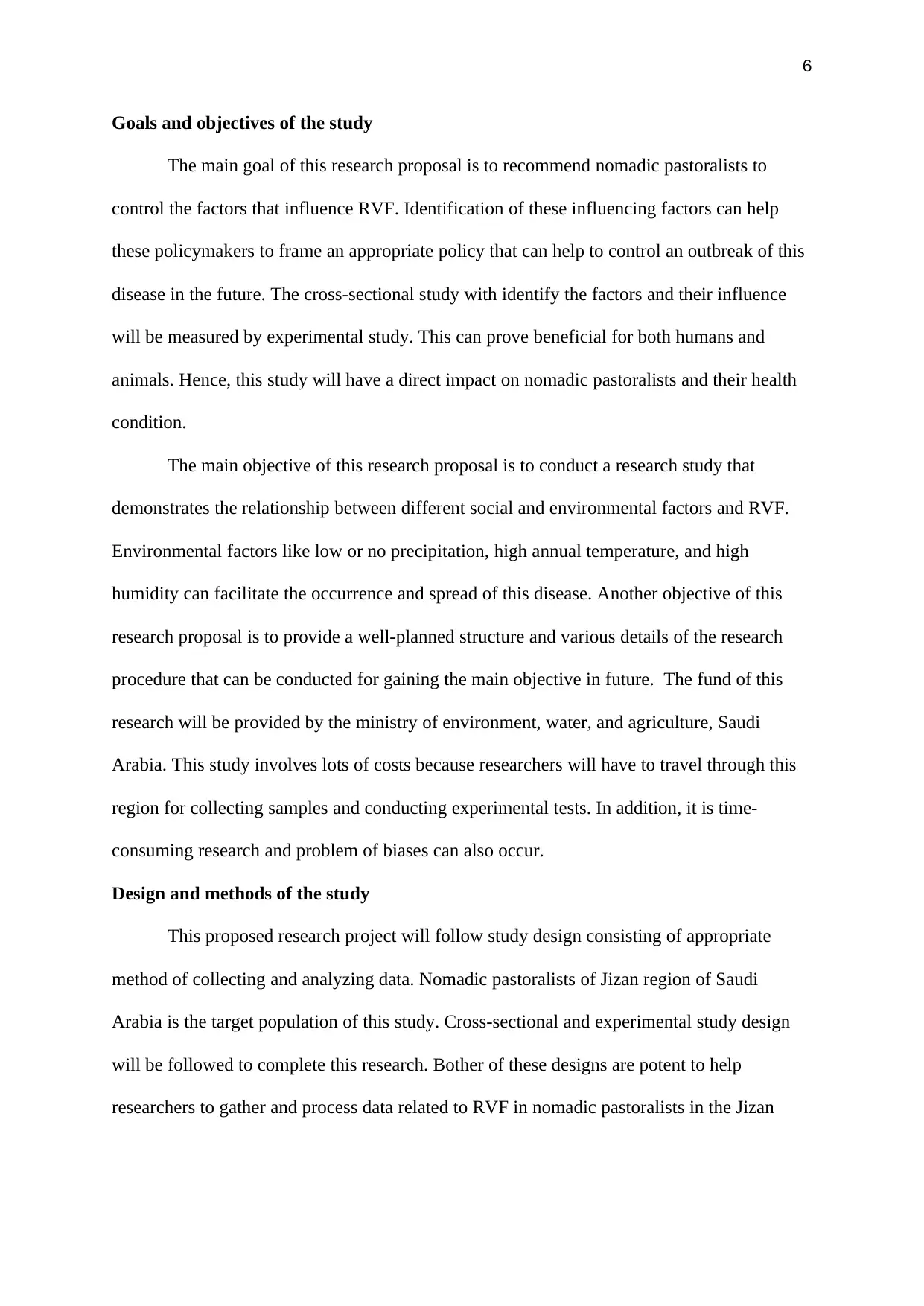
6
Goals and objectives of the study
The main goal of this research proposal is to recommend nomadic pastoralists to
control the factors that influence RVF. Identification of these influencing factors can help
these policymakers to frame an appropriate policy that can help to control an outbreak of this
disease in the future. The cross-sectional study with identify the factors and their influence
will be measured by experimental study. This can prove beneficial for both humans and
animals. Hence, this study will have a direct impact on nomadic pastoralists and their health
condition.
The main objective of this research proposal is to conduct a research study that
demonstrates the relationship between different social and environmental factors and RVF.
Environmental factors like low or no precipitation, high annual temperature, and high
humidity can facilitate the occurrence and spread of this disease. Another objective of this
research proposal is to provide a well-planned structure and various details of the research
procedure that can be conducted for gaining the main objective in future. The fund of this
research will be provided by the ministry of environment, water, and agriculture, Saudi
Arabia. This study involves lots of costs because researchers will have to travel through this
region for collecting samples and conducting experimental tests. In addition, it is time-
consuming research and problem of biases can also occur.
Design and methods of the study
This proposed research project will follow study design consisting of appropriate
method of collecting and analyzing data. Nomadic pastoralists of Jizan region of Saudi
Arabia is the target population of this study. Cross-sectional and experimental study design
will be followed to complete this research. Bother of these designs are potent to help
researchers to gather and process data related to RVF in nomadic pastoralists in the Jizan
Goals and objectives of the study
The main goal of this research proposal is to recommend nomadic pastoralists to
control the factors that influence RVF. Identification of these influencing factors can help
these policymakers to frame an appropriate policy that can help to control an outbreak of this
disease in the future. The cross-sectional study with identify the factors and their influence
will be measured by experimental study. This can prove beneficial for both humans and
animals. Hence, this study will have a direct impact on nomadic pastoralists and their health
condition.
The main objective of this research proposal is to conduct a research study that
demonstrates the relationship between different social and environmental factors and RVF.
Environmental factors like low or no precipitation, high annual temperature, and high
humidity can facilitate the occurrence and spread of this disease. Another objective of this
research proposal is to provide a well-planned structure and various details of the research
procedure that can be conducted for gaining the main objective in future. The fund of this
research will be provided by the ministry of environment, water, and agriculture, Saudi
Arabia. This study involves lots of costs because researchers will have to travel through this
region for collecting samples and conducting experimental tests. In addition, it is time-
consuming research and problem of biases can also occur.
Design and methods of the study
This proposed research project will follow study design consisting of appropriate
method of collecting and analyzing data. Nomadic pastoralists of Jizan region of Saudi
Arabia is the target population of this study. Cross-sectional and experimental study design
will be followed to complete this research. Bother of these designs are potent to help
researchers to gather and process data related to RVF in nomadic pastoralists in the Jizan
⊘ This is a preview!⊘
Do you want full access?
Subscribe today to unlock all pages.

Trusted by 1+ million students worldwide
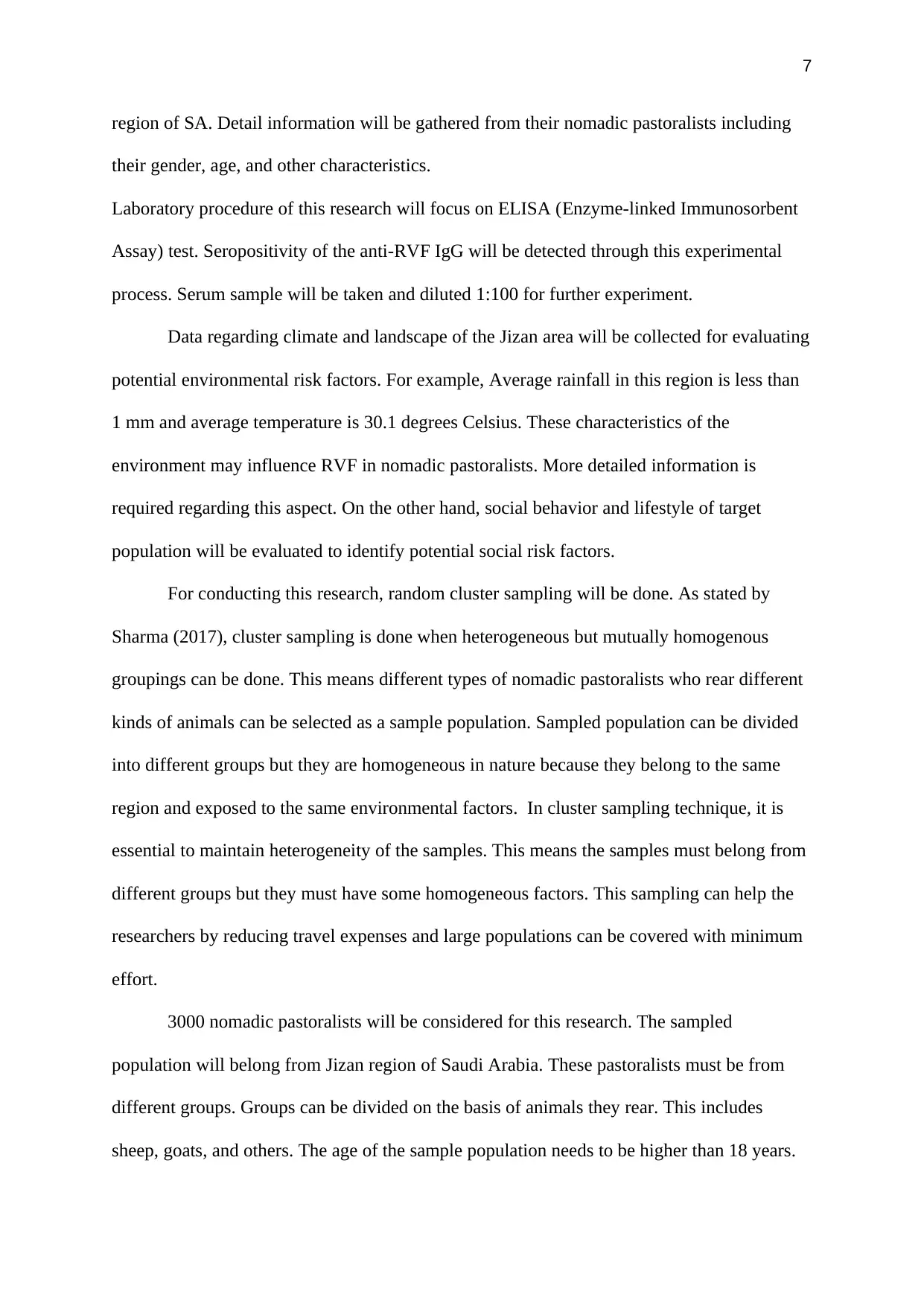
7
region of SA. Detail information will be gathered from their nomadic pastoralists including
their gender, age, and other characteristics.
Laboratory procedure of this research will focus on ELISA (Enzyme-linked Immunosorbent
Assay) test. Seropositivity of the anti-RVF IgG will be detected through this experimental
process. Serum sample will be taken and diluted 1:100 for further experiment.
Data regarding climate and landscape of the Jizan area will be collected for evaluating
potential environmental risk factors. For example, Average rainfall in this region is less than
1 mm and average temperature is 30.1 degrees Celsius. These characteristics of the
environment may influence RVF in nomadic pastoralists. More detailed information is
required regarding this aspect. On the other hand, social behavior and lifestyle of target
population will be evaluated to identify potential social risk factors.
For conducting this research, random cluster sampling will be done. As stated by
Sharma (2017), cluster sampling is done when heterogeneous but mutually homogenous
groupings can be done. This means different types of nomadic pastoralists who rear different
kinds of animals can be selected as a sample population. Sampled population can be divided
into different groups but they are homogeneous in nature because they belong to the same
region and exposed to the same environmental factors. In cluster sampling technique, it is
essential to maintain heterogeneity of the samples. This means the samples must belong from
different groups but they must have some homogeneous factors. This sampling can help the
researchers by reducing travel expenses and large populations can be covered with minimum
effort.
3000 nomadic pastoralists will be considered for this research. The sampled
population will belong from Jizan region of Saudi Arabia. These pastoralists must be from
different groups. Groups can be divided on the basis of animals they rear. This includes
sheep, goats, and others. The age of the sample population needs to be higher than 18 years.
region of SA. Detail information will be gathered from their nomadic pastoralists including
their gender, age, and other characteristics.
Laboratory procedure of this research will focus on ELISA (Enzyme-linked Immunosorbent
Assay) test. Seropositivity of the anti-RVF IgG will be detected through this experimental
process. Serum sample will be taken and diluted 1:100 for further experiment.
Data regarding climate and landscape of the Jizan area will be collected for evaluating
potential environmental risk factors. For example, Average rainfall in this region is less than
1 mm and average temperature is 30.1 degrees Celsius. These characteristics of the
environment may influence RVF in nomadic pastoralists. More detailed information is
required regarding this aspect. On the other hand, social behavior and lifestyle of target
population will be evaluated to identify potential social risk factors.
For conducting this research, random cluster sampling will be done. As stated by
Sharma (2017), cluster sampling is done when heterogeneous but mutually homogenous
groupings can be done. This means different types of nomadic pastoralists who rear different
kinds of animals can be selected as a sample population. Sampled population can be divided
into different groups but they are homogeneous in nature because they belong to the same
region and exposed to the same environmental factors. In cluster sampling technique, it is
essential to maintain heterogeneity of the samples. This means the samples must belong from
different groups but they must have some homogeneous factors. This sampling can help the
researchers by reducing travel expenses and large populations can be covered with minimum
effort.
3000 nomadic pastoralists will be considered for this research. The sampled
population will belong from Jizan region of Saudi Arabia. These pastoralists must be from
different groups. Groups can be divided on the basis of animals they rear. This includes
sheep, goats, and others. The age of the sample population needs to be higher than 18 years.
Paraphrase This Document
Need a fresh take? Get an instant paraphrase of this document with our AI Paraphraser
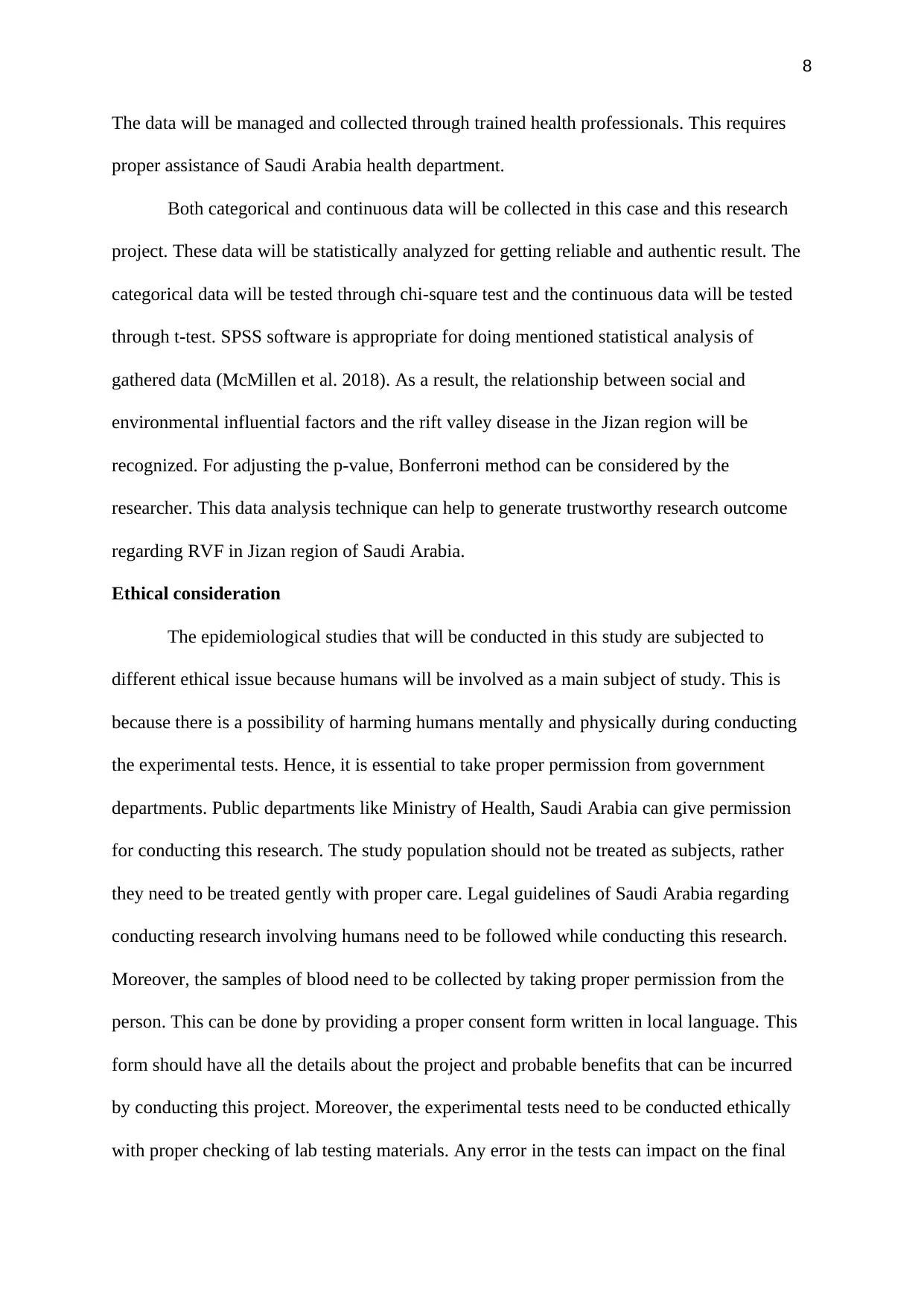
8
The data will be managed and collected through trained health professionals. This requires
proper assistance of Saudi Arabia health department.
Both categorical and continuous data will be collected in this case and this research
project. These data will be statistically analyzed for getting reliable and authentic result. The
categorical data will be tested through chi-square test and the continuous data will be tested
through t-test. SPSS software is appropriate for doing mentioned statistical analysis of
gathered data (McMillen et al. 2018). As a result, the relationship between social and
environmental influential factors and the rift valley disease in the Jizan region will be
recognized. For adjusting the p-value, Bonferroni method can be considered by the
researcher. This data analysis technique can help to generate trustworthy research outcome
regarding RVF in Jizan region of Saudi Arabia.
Ethical consideration
The epidemiological studies that will be conducted in this study are subjected to
different ethical issue because humans will be involved as a main subject of study. This is
because there is a possibility of harming humans mentally and physically during conducting
the experimental tests. Hence, it is essential to take proper permission from government
departments. Public departments like Ministry of Health, Saudi Arabia can give permission
for conducting this research. The study population should not be treated as subjects, rather
they need to be treated gently with proper care. Legal guidelines of Saudi Arabia regarding
conducting research involving humans need to be followed while conducting this research.
Moreover, the samples of blood need to be collected by taking proper permission from the
person. This can be done by providing a proper consent form written in local language. This
form should have all the details about the project and probable benefits that can be incurred
by conducting this project. Moreover, the experimental tests need to be conducted ethically
with proper checking of lab testing materials. Any error in the tests can impact on the final
The data will be managed and collected through trained health professionals. This requires
proper assistance of Saudi Arabia health department.
Both categorical and continuous data will be collected in this case and this research
project. These data will be statistically analyzed for getting reliable and authentic result. The
categorical data will be tested through chi-square test and the continuous data will be tested
through t-test. SPSS software is appropriate for doing mentioned statistical analysis of
gathered data (McMillen et al. 2018). As a result, the relationship between social and
environmental influential factors and the rift valley disease in the Jizan region will be
recognized. For adjusting the p-value, Bonferroni method can be considered by the
researcher. This data analysis technique can help to generate trustworthy research outcome
regarding RVF in Jizan region of Saudi Arabia.
Ethical consideration
The epidemiological studies that will be conducted in this study are subjected to
different ethical issue because humans will be involved as a main subject of study. This is
because there is a possibility of harming humans mentally and physically during conducting
the experimental tests. Hence, it is essential to take proper permission from government
departments. Public departments like Ministry of Health, Saudi Arabia can give permission
for conducting this research. The study population should not be treated as subjects, rather
they need to be treated gently with proper care. Legal guidelines of Saudi Arabia regarding
conducting research involving humans need to be followed while conducting this research.
Moreover, the samples of blood need to be collected by taking proper permission from the
person. This can be done by providing a proper consent form written in local language. This
form should have all the details about the project and probable benefits that can be incurred
by conducting this project. Moreover, the experimental tests need to be conducted ethically
with proper checking of lab testing materials. Any error in the tests can impact on the final
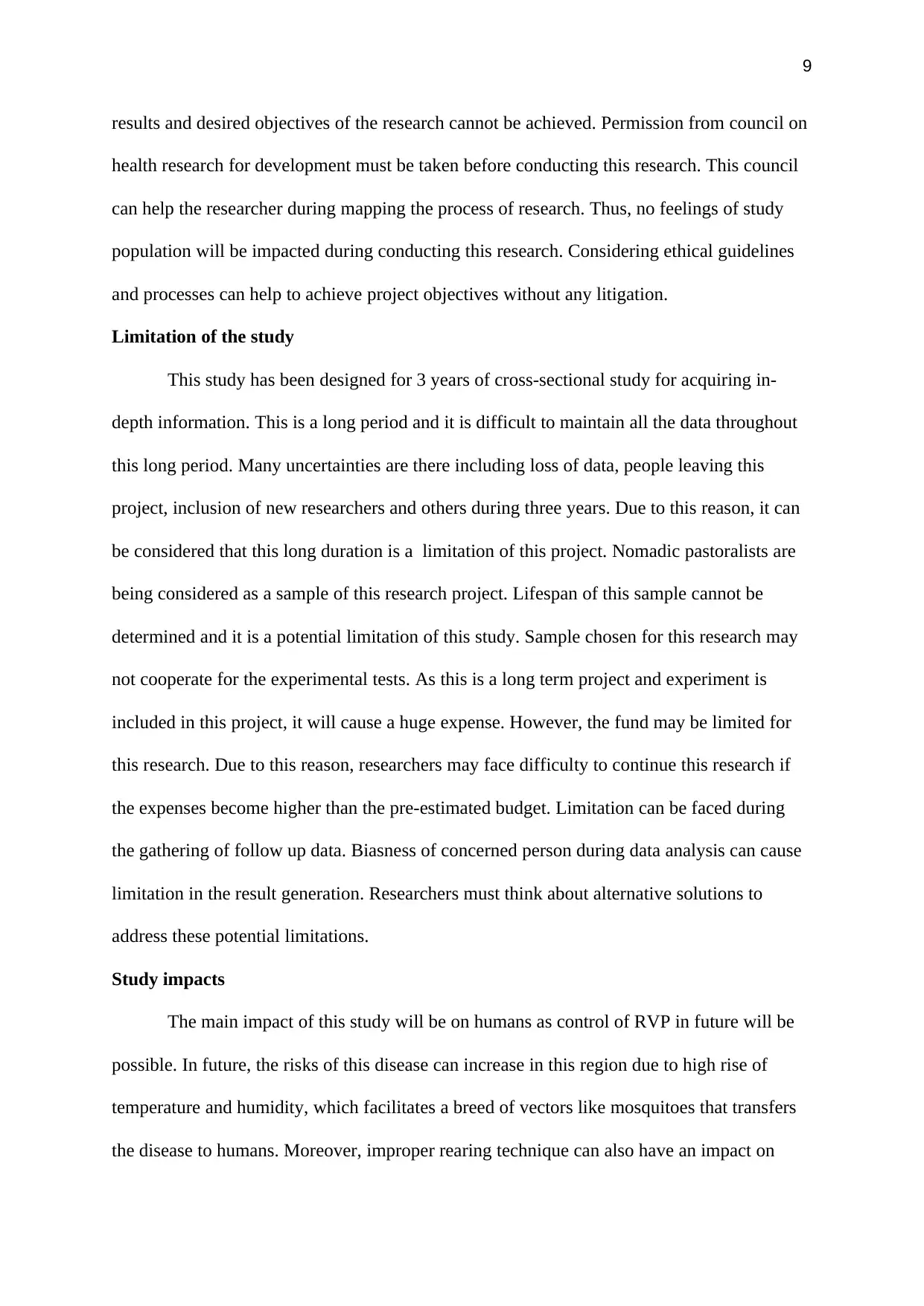
9
results and desired objectives of the research cannot be achieved. Permission from council on
health research for development must be taken before conducting this research. This council
can help the researcher during mapping the process of research. Thus, no feelings of study
population will be impacted during conducting this research. Considering ethical guidelines
and processes can help to achieve project objectives without any litigation.
Limitation of the study
This study has been designed for 3 years of cross-sectional study for acquiring in-
depth information. This is a long period and it is difficult to maintain all the data throughout
this long period. Many uncertainties are there including loss of data, people leaving this
project, inclusion of new researchers and others during three years. Due to this reason, it can
be considered that this long duration is a limitation of this project. Nomadic pastoralists are
being considered as a sample of this research project. Lifespan of this sample cannot be
determined and it is a potential limitation of this study. Sample chosen for this research may
not cooperate for the experimental tests. As this is a long term project and experiment is
included in this project, it will cause a huge expense. However, the fund may be limited for
this research. Due to this reason, researchers may face difficulty to continue this research if
the expenses become higher than the pre-estimated budget. Limitation can be faced during
the gathering of follow up data. Biasness of concerned person during data analysis can cause
limitation in the result generation. Researchers must think about alternative solutions to
address these potential limitations.
Study impacts
The main impact of this study will be on humans as control of RVP in future will be
possible. In future, the risks of this disease can increase in this region due to high rise of
temperature and humidity, which facilitates a breed of vectors like mosquitoes that transfers
the disease to humans. Moreover, improper rearing technique can also have an impact on
results and desired objectives of the research cannot be achieved. Permission from council on
health research for development must be taken before conducting this research. This council
can help the researcher during mapping the process of research. Thus, no feelings of study
population will be impacted during conducting this research. Considering ethical guidelines
and processes can help to achieve project objectives without any litigation.
Limitation of the study
This study has been designed for 3 years of cross-sectional study for acquiring in-
depth information. This is a long period and it is difficult to maintain all the data throughout
this long period. Many uncertainties are there including loss of data, people leaving this
project, inclusion of new researchers and others during three years. Due to this reason, it can
be considered that this long duration is a limitation of this project. Nomadic pastoralists are
being considered as a sample of this research project. Lifespan of this sample cannot be
determined and it is a potential limitation of this study. Sample chosen for this research may
not cooperate for the experimental tests. As this is a long term project and experiment is
included in this project, it will cause a huge expense. However, the fund may be limited for
this research. Due to this reason, researchers may face difficulty to continue this research if
the expenses become higher than the pre-estimated budget. Limitation can be faced during
the gathering of follow up data. Biasness of concerned person during data analysis can cause
limitation in the result generation. Researchers must think about alternative solutions to
address these potential limitations.
Study impacts
The main impact of this study will be on humans as control of RVP in future will be
possible. In future, the risks of this disease can increase in this region due to high rise of
temperature and humidity, which facilitates a breed of vectors like mosquitoes that transfers
the disease to humans. Moreover, improper rearing technique can also have an impact on
⊘ This is a preview!⊘
Do you want full access?
Subscribe today to unlock all pages.

Trusted by 1+ million students worldwide
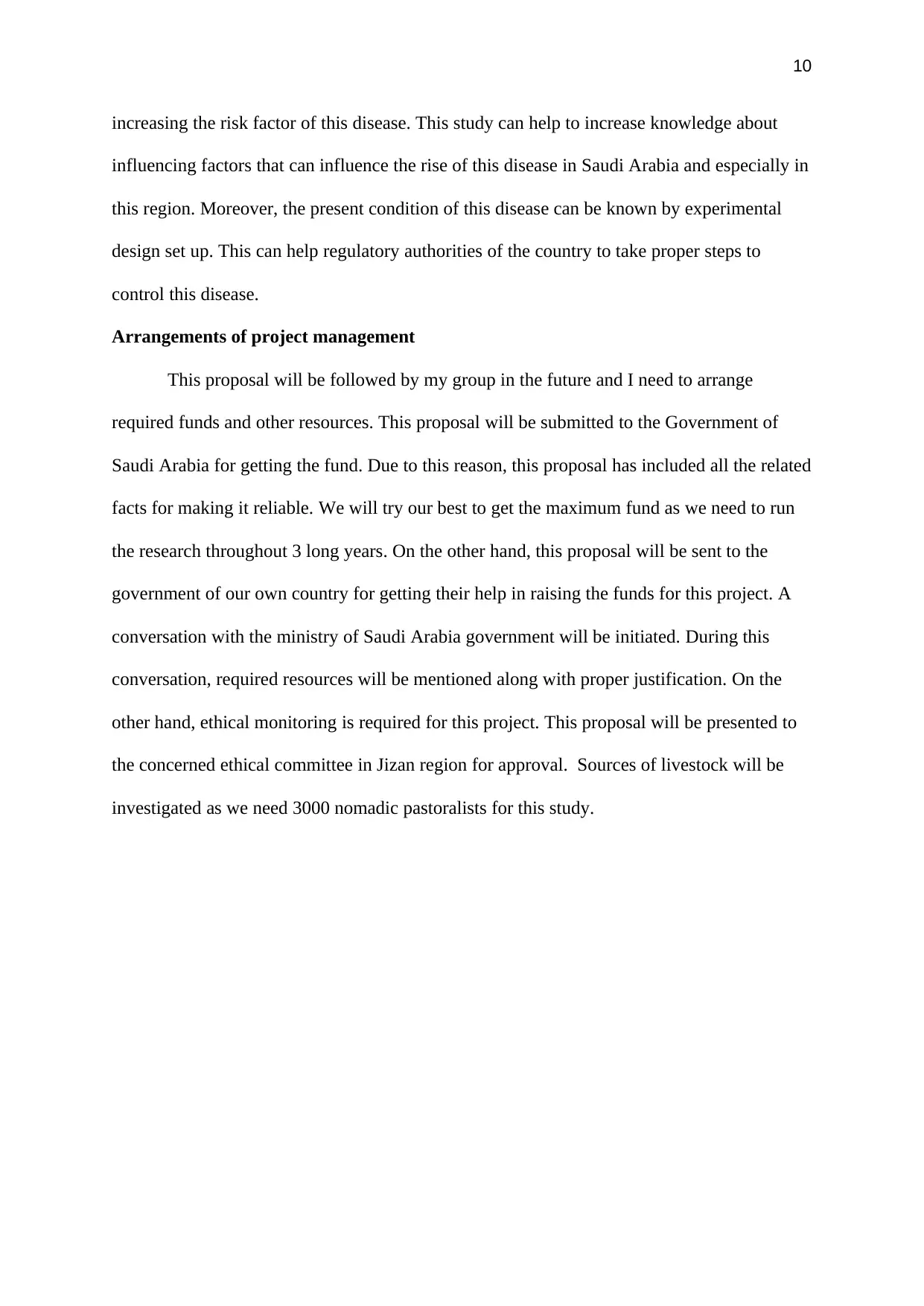
10
increasing the risk factor of this disease. This study can help to increase knowledge about
influencing factors that can influence the rise of this disease in Saudi Arabia and especially in
this region. Moreover, the present condition of this disease can be known by experimental
design set up. This can help regulatory authorities of the country to take proper steps to
control this disease.
Arrangements of project management
This proposal will be followed by my group in the future and I need to arrange
required funds and other resources. This proposal will be submitted to the Government of
Saudi Arabia for getting the fund. Due to this reason, this proposal has included all the related
facts for making it reliable. We will try our best to get the maximum fund as we need to run
the research throughout 3 long years. On the other hand, this proposal will be sent to the
government of our own country for getting their help in raising the funds for this project. A
conversation with the ministry of Saudi Arabia government will be initiated. During this
conversation, required resources will be mentioned along with proper justification. On the
other hand, ethical monitoring is required for this project. This proposal will be presented to
the concerned ethical committee in Jizan region for approval. Sources of livestock will be
investigated as we need 3000 nomadic pastoralists for this study.
increasing the risk factor of this disease. This study can help to increase knowledge about
influencing factors that can influence the rise of this disease in Saudi Arabia and especially in
this region. Moreover, the present condition of this disease can be known by experimental
design set up. This can help regulatory authorities of the country to take proper steps to
control this disease.
Arrangements of project management
This proposal will be followed by my group in the future and I need to arrange
required funds and other resources. This proposal will be submitted to the Government of
Saudi Arabia for getting the fund. Due to this reason, this proposal has included all the related
facts for making it reliable. We will try our best to get the maximum fund as we need to run
the research throughout 3 long years. On the other hand, this proposal will be sent to the
government of our own country for getting their help in raising the funds for this project. A
conversation with the ministry of Saudi Arabia government will be initiated. During this
conversation, required resources will be mentioned along with proper justification. On the
other hand, ethical monitoring is required for this project. This proposal will be presented to
the concerned ethical committee in Jizan region for approval. Sources of livestock will be
investigated as we need 3000 nomadic pastoralists for this study.
Paraphrase This Document
Need a fresh take? Get an instant paraphrase of this document with our AI Paraphraser
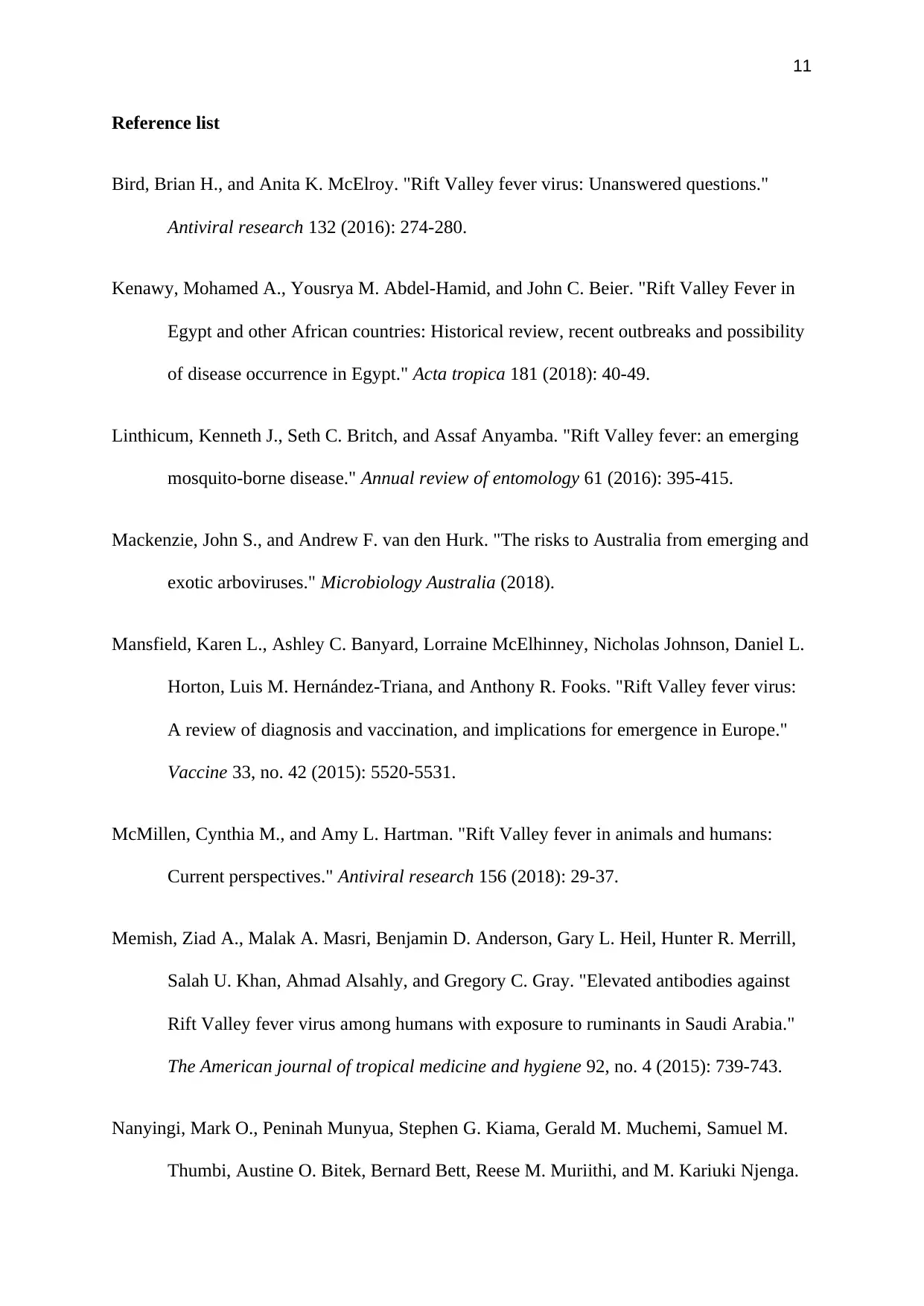
11
Reference list
Bird, Brian H., and Anita K. McElroy. "Rift Valley fever virus: Unanswered questions."
Antiviral research 132 (2016): 274-280.
Kenawy, Mohamed A., Yousrya M. Abdel-Hamid, and John C. Beier. "Rift Valley Fever in
Egypt and other African countries: Historical review, recent outbreaks and possibility
of disease occurrence in Egypt." Acta tropica 181 (2018): 40-49.
Linthicum, Kenneth J., Seth C. Britch, and Assaf Anyamba. "Rift Valley fever: an emerging
mosquito-borne disease." Annual review of entomology 61 (2016): 395-415.
Mackenzie, John S., and Andrew F. van den Hurk. "The risks to Australia from emerging and
exotic arboviruses." Microbiology Australia (2018).
Mansfield, Karen L., Ashley C. Banyard, Lorraine McElhinney, Nicholas Johnson, Daniel L.
Horton, Luis M. Hernández-Triana, and Anthony R. Fooks. "Rift Valley fever virus:
A review of diagnosis and vaccination, and implications for emergence in Europe."
Vaccine 33, no. 42 (2015): 5520-5531.
McMillen, Cynthia M., and Amy L. Hartman. "Rift Valley fever in animals and humans:
Current perspectives." Antiviral research 156 (2018): 29-37.
Memish, Ziad A., Malak A. Masri, Benjamin D. Anderson, Gary L. Heil, Hunter R. Merrill,
Salah U. Khan, Ahmad Alsahly, and Gregory C. Gray. "Elevated antibodies against
Rift Valley fever virus among humans with exposure to ruminants in Saudi Arabia."
The American journal of tropical medicine and hygiene 92, no. 4 (2015): 739-743.
Nanyingi, Mark O., Peninah Munyua, Stephen G. Kiama, Gerald M. Muchemi, Samuel M.
Thumbi, Austine O. Bitek, Bernard Bett, Reese M. Muriithi, and M. Kariuki Njenga.
Reference list
Bird, Brian H., and Anita K. McElroy. "Rift Valley fever virus: Unanswered questions."
Antiviral research 132 (2016): 274-280.
Kenawy, Mohamed A., Yousrya M. Abdel-Hamid, and John C. Beier. "Rift Valley Fever in
Egypt and other African countries: Historical review, recent outbreaks and possibility
of disease occurrence in Egypt." Acta tropica 181 (2018): 40-49.
Linthicum, Kenneth J., Seth C. Britch, and Assaf Anyamba. "Rift Valley fever: an emerging
mosquito-borne disease." Annual review of entomology 61 (2016): 395-415.
Mackenzie, John S., and Andrew F. van den Hurk. "The risks to Australia from emerging and
exotic arboviruses." Microbiology Australia (2018).
Mansfield, Karen L., Ashley C. Banyard, Lorraine McElhinney, Nicholas Johnson, Daniel L.
Horton, Luis M. Hernández-Triana, and Anthony R. Fooks. "Rift Valley fever virus:
A review of diagnosis and vaccination, and implications for emergence in Europe."
Vaccine 33, no. 42 (2015): 5520-5531.
McMillen, Cynthia M., and Amy L. Hartman. "Rift Valley fever in animals and humans:
Current perspectives." Antiviral research 156 (2018): 29-37.
Memish, Ziad A., Malak A. Masri, Benjamin D. Anderson, Gary L. Heil, Hunter R. Merrill,
Salah U. Khan, Ahmad Alsahly, and Gregory C. Gray. "Elevated antibodies against
Rift Valley fever virus among humans with exposure to ruminants in Saudi Arabia."
The American journal of tropical medicine and hygiene 92, no. 4 (2015): 739-743.
Nanyingi, Mark O., Peninah Munyua, Stephen G. Kiama, Gerald M. Muchemi, Samuel M.
Thumbi, Austine O. Bitek, Bernard Bett, Reese M. Muriithi, and M. Kariuki Njenga.
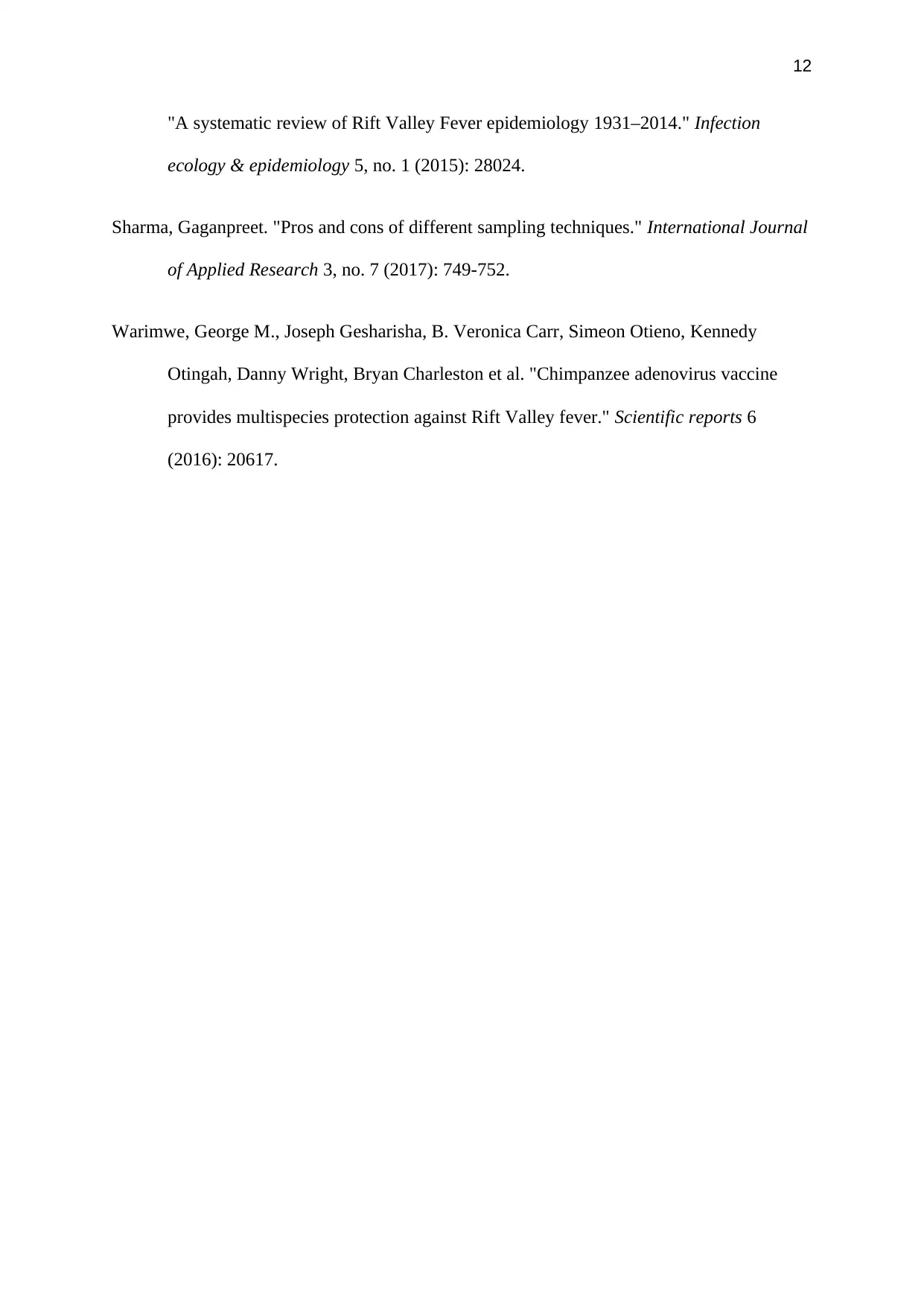
12
"A systematic review of Rift Valley Fever epidemiology 1931–2014." Infection
ecology & epidemiology 5, no. 1 (2015): 28024.
Sharma, Gaganpreet. "Pros and cons of different sampling techniques." International Journal
of Applied Research 3, no. 7 (2017): 749-752.
Warimwe, George M., Joseph Gesharisha, B. Veronica Carr, Simeon Otieno, Kennedy
Otingah, Danny Wright, Bryan Charleston et al. "Chimpanzee adenovirus vaccine
provides multispecies protection against Rift Valley fever." Scientific reports 6
(2016): 20617.
"A systematic review of Rift Valley Fever epidemiology 1931–2014." Infection
ecology & epidemiology 5, no. 1 (2015): 28024.
Sharma, Gaganpreet. "Pros and cons of different sampling techniques." International Journal
of Applied Research 3, no. 7 (2017): 749-752.
Warimwe, George M., Joseph Gesharisha, B. Veronica Carr, Simeon Otieno, Kennedy
Otingah, Danny Wright, Bryan Charleston et al. "Chimpanzee adenovirus vaccine
provides multispecies protection against Rift Valley fever." Scientific reports 6
(2016): 20617.
⊘ This is a preview!⊘
Do you want full access?
Subscribe today to unlock all pages.

Trusted by 1+ million students worldwide
1 out of 12
Your All-in-One AI-Powered Toolkit for Academic Success.
+13062052269
info@desklib.com
Available 24*7 on WhatsApp / Email
![[object Object]](/_next/static/media/star-bottom.7253800d.svg)
Unlock your academic potential
Copyright © 2020–2025 A2Z Services. All Rights Reserved. Developed and managed by ZUCOL.

